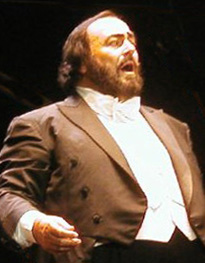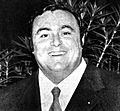Luciano Pavarotti facts for kids
Quick facts for kids
Luciano Pavarotti
|
|
|---|---|

Pavarotti singing on June 15, 2002 at a concert in the Stade Vélodrome in Marseille
|
|
| Background information | |
| Born | 12 October 1935 Modena, Italy |
| Died | 6 September 2007 (aged 71) Modena, Italy |
| Occupation(s) | Opera singer (tenor) |
| Years active | 1955–2006 |
Luciano Pavarotti (October 12, 1935 – September 6, 2007) was a famous Italian tenor. A tenor is a type of male singer with a high voice. He was one of the most popular singers in the world during his time.
Pavarotti sang in opera and also in other kinds of music. He was known for his concerts on TV and for being one of the "Three Tenors." The other two tenors were Plácido Domingo and José Carreras. Pavarotti became super famous after singing the song Nessun Dorma from the opera Turandot. He sang it for the opening of the 1990 FIFA World Cup in Italy.
Pavarotti also did a lot of charity work. He helped raise money for refugees and the Red Cross.
Contents
Early Life of Luciano Pavarotti
Luciano Pavarotti was born in Modena, a city in northern Italy. His father was a baker who loved to sing. His mother worked in a cigar factory. His family did not have much money. During World War II, they lived on a farm in the countryside.
Pavarotti started listening to his father's records. These records had famous tenors like Enrico Caruso. When he was about nine, he began singing with his father. They sang in a small church choir. Luciano was a normal boy who liked playing football. He even thought about becoming a professional soccer goalkeeper. But his mother wanted him to be a teacher. His father said he would support him, but only until he was 30. After that, Luciano would need to earn his own money.
Pavarotti started serious singing lessons in 1954 when he was 19. He met a singer named Adua Veroni and they got married in 1961. To earn money, Pavarotti worked as a teacher. Then he became an insurance salesman. For several years, he only gave a few free recitals. Then he had problems with his throat and stopped singing for a short time. Surprisingly, this break helped his voice become really good.
Pavarotti's Singing Career
Pavarotti had his first opera performance on April 29, 1961. He played the role of Rodolfo in La bohème by Puccini. This first show was in Reggio Emilia, Italy. Soon, he was singing in famous places like the Vienna State Opera. He also sang in the United States with Joan Sutherland.
In 1965, he sang at La Scala. This is one of the most famous opera houses in the world. He performed in a well-known show of La Bohème. Later that year, he sang as Tonio in La fille du régiment at Covent Garden. His performances in this role made people call him the "King of the High Cs." A "High C" is a very high note for a tenor to sing.
Pavarotti learned many more opera roles. He sang all over the world. In 1972, he performed La fille du régiment again. This time it was at the Metropolitan Opera in New York. The audience was amazed when he sang nine high Cs. They clapped so much that he came back out for 17 curtain calls. A curtain call is when a performer comes back on stage after a show because the audience is clapping for them.
In March 1977, he sang Rodolfo in La bohème for a TV show called Live From The Met. Millions of people watched this show. He won many Grammy awards. He also got platinum and gold discs for selling lots of music.
In 1976, Pavarotti sang at the Salzburg Festival. He returned to the festival many times. In 1977, he was on the cover of Time Magazine. That same year, he sang at the Vienna State Opera again after 14 years.
Pavarotti had his first international recital in 1973 in Liberty, Missouri. He was nervous and had a cold, so he held a handkerchief in his hand. After that, the handkerchief became a common sight during his solo shows.
Becoming a Global Star
In the early 1980s, Pavarotti started The Pavarotti International Voice Competition. This competition helped young singers begin their careers. He performed with the winners in 1982. They even traveled to China.
In 1992, Pavarotti sang in Don Carlo at La Scala. Some people in the audience did not like his performance and booed him. Pavarotti never sang at La Scala again after that.
Pavarotti became even more famous around the world in 1990. His song "Nessun Dorma" from Turandot was used for the BBC TV coverage of the 1990 FIFA World Cup in Italy. This song made him a pop star, and it became his signature tune.
After this, the "Three Tenors" concert happened. It was held before the World Cup final in Rome. Pavarotti sang with Plácido Domingo and José Carreras. This concert became the biggest selling classical music record ever. A special moment was when Pavarotti sang a famous part of "'O Sole Mio". Domingo and Carreras copied him, and the audience loved it. This was one of the most memorable moments in opera history.
Throughout the 1990s, Pavarotti performed in many huge outdoor concerts. His concert in London's Hyde Park had 150,000 people. In June 1993, over 500,000 people watched him in New York's Central Park. Millions more watched on TV. The next September, he sang near the Eiffel Tower in Paris for about 300,000 people. The Three Tenors also performed at later Football World Cups in Los Angeles (1994), Paris (1998), and Yokohama (2002).
Pavarotti's journey to stardom had some challenges. He sometimes canceled performances. This earned him the nickname "The King of Cancellations" and made some opera houses unhappy. In 1998, Pavarotti received a very special award: the Grammy Legend Award.
Later Years
In 2002, Pavarotti stopped working with Herbert Breslin, his manager of 36 years. On December 13, 2003, he married Nicoletta Mantovani, who used to be his personal assistant. They already had a daughter together. He started his farewell tour in 2004, when he was 69 years old. He performed for over 40 years on stage.
Pavarotti gave his last opera performance at the New York Metropolitan Opera on March 13, 2004. He played the painter Mario Cavaradossi in Puccini's Tosca. The audience gave him a standing ovation for 12 minutes.
Death
In March 2005, Pavarotti had an operation on his neck. His health started to get worse. In July 2006, doctors found out he had pancreatic cancer. He died from the disease on September 6, 2007, at his home in Modena. He was 71 years old.
Images for kids
-
With Joan Sutherland in I puritani (1976)
-
Elton John and Pavarotti in Modena, 1996
-
Luciano Pavarotti performing on 15 June 2002 at a concert in the Stade Vélodrome in Marseille
See also
 In Spanish: Luciano Pavarotti para niños
In Spanish: Luciano Pavarotti para niños











